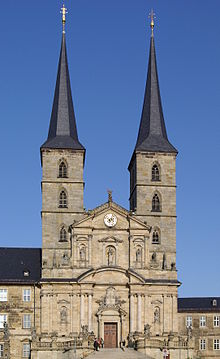St Michael's Church, Bamberg
St. Michael's Church, also known as the Michaelskirche (Church of St Michael), is a church in Bamberg. It was built in the 12th century. It stands on the top of a very high hill overlooking the town of Bamberg. It can be seen from nearly all directions. Bamberg is built on seven hills, each with a building at the top. The hill on which the St Michael’s Church stands is the highest one. An old, cobbled road with some ancient houses leads from the cathedral up to the church. Not far beyond the church are fields and woods.

The church is built in the Romanesque style. It used to be the church of a Benedictine monastery. The monastery was secularized in 1803. There is now an almshouse there as well as a museum and municipal art collections.
History
changeEmperor Heinrich II (Henry II) was the founder of the Bishopric of Bamberg. The first bishop of Bamberg was Eberhard, who founded the abbey of St Michael. It belonged to the bishop. The abbot had to obey the bishop. The monks who came to live there came from the towns of Amorbach and Fulda.
In the 12th century the abbey flourished. This was the time of Bishop Otto of Bamberg. The abbey started to become more independent of the bishop.
The abbey went through hard times during the wars around 1525. In the 17th and 18th centuries it went through better times again. When the bishops lost their political power in 1803 the abbey started to belong to the town. The people asked for the almshouses in the town to be moved to the St Michael abbey. There is still a home for old people there today.
Inside the church
changeBehind the altar is the tomb of Bishop Otto of Bamberg which dates from 1443. There is a hole in the middle of the tomb which is just big enough for a person to crawl through. Visitors to the church like to crawl through the hole, because it is said that it helps people who have backache.
The roof of the nave has paintings of 580 different kinds of plants. These include plants from faraway countries, e.g. pineapple, cotton, pomegranate and tobacco as well as plants that are found locally. The paintings date from the 17th century. Many of the plants were grown in the herb gardens around the church.
In the side isles of the church the ceiling has more paintings. These include paintings of birds.